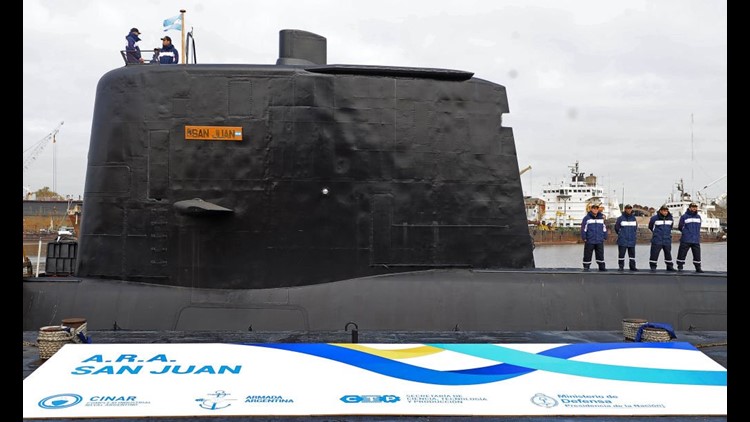BUENOS AIRES – Argentina’s navy on Monday picked up noises that could be a distress signal from the crew of a missing submarine and said the sub’s captain reported a “failure” in the vessel’s battery system before it disappeared.
The sonar systems of two ships detected noises sounding like tools being banged against the hull of a submarine, according to a senior US Navy official familiar with the Navy’s assistance in the search for the Argentine vessel.
The official said that crews of submarines in distress bang on the vessel’s hull to alert passing ships to their location. The missing submarine — ARA San Juan — has a crew of 44.
The Argentine navy was able to fix the rough location of the sounds the two ships picked up and is now concentrating its search in an area of 35 square nautical miles approximately 330 miles off the coast of Argentina, the official said.
The submarine was heading from a base in southern Argentina’s Tierra del Fuego archipelago to its home port in Mar del Plata. It was scheduled to arrive there Sunday.
‘Failure’ reported in the vessel’s battery system
The vessel’s captain reported a “failure” in the vessel’s battery system shortly before it disappeared last week, the country’s Navy spokesman Gabriel Galeazzi said Monday.
After he reported the sub had experienced a “short circuit,” he was told to “change course and return to Mar del Plata,” said Galeazzi.
This type of problem is considered routine and the vessel’s crew was reported safe, he added.
The Argentine navy had one more communication with the captain before the sub went missing, said Galeazzi. The navy did not give details of the content of that final communication.
On Saturday, seven reported communication attempts were initially believed to originate from the San Juan — but on Monday officials said the radio calls had not come from the missing sub.
The last confirmed contact with the submarine was Wednesday, the Argentine navy said.
A US Navy P-8A Poseidon aircraft, also known as a submarine hunter, is now assisting in the search area.
The US official said that the waters of the Atlantic Ocean where the sounds originated are extremely deep. The official stressed that search efforts thus far have yet to locate the submarine.
The Argentine military has also been working with a US company that specializes in satellite communication to determine the location of the submarine.
The search area, off the Patagonia coast, is notorious for strong storms.
Clock is ticking
In the “worst-case scenario,” the missing sub could run out of oxygen in two days, said Argentine navy spokesman Enrique Balbi.
Under normal circumstances, the vessel has sufficient fuel, water, oil and oxygen to operate for 90 days without external help, said Balbi, and the vessel could “snorkel” — or raise a tube to the surface — “to charge batteries and draw fresh air for the crew.”
If the sub is bobbing adrift on the surface and the hatch is open, it will have an available air supply and enough food for about 30 days, he said.
If it is immersed and cannot raise a snorkel, oxygen may last about seven days. When the sub last made contact on Wednesday, five days ago, it was immersed, Balbi said. “This phase of search and rescue is critical,” said Balbi. “This is why we are deploying all resources with high tech sensors. We welcome the help we have received to find them.”



